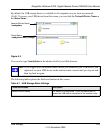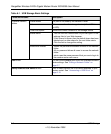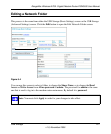
RangeMax Wireless-N DSL Gigabit Modem Router DGN3500 User Manual
6-2 USB Storage
v1.0, November 2009
USB Drive Requirements
The modem router works with 1.0 and 1.1 (USB Full Speed) and 2.0 (USB High Speed) standards.
The approximate USB bus speeds are shown below.
Actual bus speeds can vary, depending on the CPU speed, memory, speed of the network, and
other variables.
The modem router should work with USB 2.0 or 1.1-compliant external flash and hard drives. For
the most up-to-date list of USB drives supported by the modem router, go to:
http://kbserver.netgear.com/kb_web_files/n101300.asp
When selecting a USB device, bear in mind the following:
• The USB port on the modem router can be used with one USB hard drive at a time. Do not
attempt to use a USB hub attached to the USB port.
• Per the USB 2.0 specification, the maximum available power is 5V @ 0.5A. Some USB
devices may exceed this requirement, in which case the device may not function or may
function erratically. Check the documentation for your USB device to be sure.
• The modem router supports FAT, FAT32, NTFS (read only) and Linux file systems.
File Sharing Scenarios
You can share files on the USB drive for a wide variety of business and recreational purposes. The
files can be any PC, Mac, or Linux file type including text files, Word, PowerPoint, Excel, MP3,
pictures, and multimedia. USB drive applications include:
• Sharing multimedia with friends and family — sharing MP3 files, pictures, and other
multimedia with local and remote users.
• Sharing resources on your network — storing files in a central location so that you do not have
to power up a computer to perform local sharing. In addition, you can share files between
Macintosh, Linux, and PC computers by using the USB drive as a go-between the systems.
• Sharing files with offsite coworkers — sharing files such as Word documents, PowerPoint
presentations, and text files with remote users.
Bus Speed/Second
USB 1.1 12 Mbits
USB 2.0 480 Mbits


















